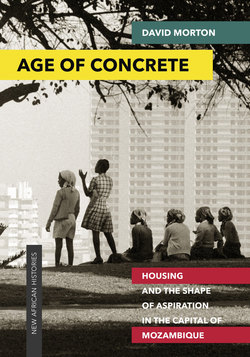Читать книгу Age of Concrete - David Morton - Страница 7
На сайте Литреса книга снята с продажи.
ОглавлениеILLUSTRATIONS
I.1. Polana Caniço, 1987
I.2. A path in the caniço, late 1970s
I.3. Map of Maputo in the late 1970s
I.4. Chamanculo, one of the oldest neighborhoods in the subúrbios, 1969
I.5. The City of Cement, 1974
1.1. The archbishop of Lourenço Marques surveys the Bairro Indígena after a storm, 1966
1.2. The curve where city meets subúrbios, 1969
1.3. The subúrbios, 1978–79
1.4. Mavalane, 1980s
1.5. Pushing a truck through suburban roads, 1971
1.6. A water fountain in the subúrbios, undated
1.7. Polana Caniço, 1988
1.8. Polana Caniço, 1987
1.9. Cement mix was often used to plaster reed houses, Maxaquene, late 1970s
1.10. Site plan and reed house floor plan in and 1.11 Maxaquene, 1976
1.12. The Guambe house, built in Chamanculo in the 1930s, in 2011
1.13. Jochua Guambe and his family, early 1950s
1.14. The Tembe house, built in Chamanculo in the early 1960s, in 2012
1.15. Firewood for sale, Minkadjuíne, 1987
1.16. João da Costa pours a drink at his Chamanculo cantina, 1960s
1.17. Dinis Marques and the da Costa children behind the Xibinhana cantina, mid-1960s
1.18. A compound in Xipamanine, 1978
1.19. The Bairro Indígena, 1940s
1.20. Lídia Manhiça Muhale, Chamanculo, 2011
2.1. View of the City of Cement from the caniço, 1960s
2.2. Traditional leader Frederico de Almeida Cumba, 1950s
2.3. Traditional leaders, police officers, and Portuguese administrators, 1950s
2.4. Frederico and his counselors hold court, 1950s
2.5. Traditional healers in Chamanculo, 1950s
2.6. A ground-rent receipt for a small plot in Chamanculo, 1958
2.7. 1960s-era Lisbon propaganda
3.1. Rute Malé inaugurates her concrete-block house, Chamanculo, 1963
3.2. Daniel Malé and Adelina Cossa at their Chamanculo home, 2011
3.3. Mozambique’s governor-general awards a property title, Matola, 1960s
3.4. “Residence of an African family under construction,” Matola, 1960s
3.5. The house of Maria Esperança Tavares, Chamanculo, 2011
3.6. The Bairro Clandestino do Aeroporto, 1969
3.7. Hulene, 1987
3.8. Concrete blocks stamped with identifying letters
3.9. Hulene, 1987
3.10. Concrete blocks, though in storage, already serve as walls, Hulene, 1987
3.11. Zinc, blocks, and reeds used together, 1987
3.12. Ceramic block construction, 1987
3.13. Hulene, 1987
3.14. Site plan and concrete house floor plan in and 3.15 Maxaquene, 1976
3.16. Fabricating concrete blocks, 1982
3.17. Shoveling stone aggregate, 1978
3.18. A street of masonry houses, Hulene, 1987
3.19. Alfredo Manjate in the courtyard of his Chamanculo home, 2011
4.1. The City of Cement, 1994
4.2. Crates of household possessions at the docks, September 1974
4.3. The Bairro da Munhuana, 1987
4.4. Samora Machel, Mozambique’s first president, Maputo, 1980
4.5. Sebastião Chitombe at his home, 2017
4.6. A broken sewage line at an apartment block in the City of Cement, 1989
4.7. Families evicted from their homes, 1994
4.8. In the City of Cement, 2002
5.1. A debate on household plot size during the parceling of Maxaquene, 1978
5.2. Maxaquene, as the project began, 1977
5.3. The urbanization commission meets with planners Pinsky and Sävfors
5.4. A neighborhood meeting to discuss the progress of the project
5.5. Residents of Maxaquene insisted that the new access roads be straight
5.6. Building a model house
5.7. “Now we are urbanizado”
5.8. A 2018 satellite image showing parts of Maxaquene and Polana Caniço
5.9. The making of a new city block in Maxaquene
5.10. People in Maxaquene demanded ready access to water
5.11. Polana Caniço and the Polana Golf Club, 2018
5.12. Maxaquene, 1978–79
C.1. Graça Ferreira builds her house, Matola, 2011
C.2. Castigo Guambe, with the blocks he fabricates and sells, Chamanculo, 2011
C.3. The City of Cement, 2017
